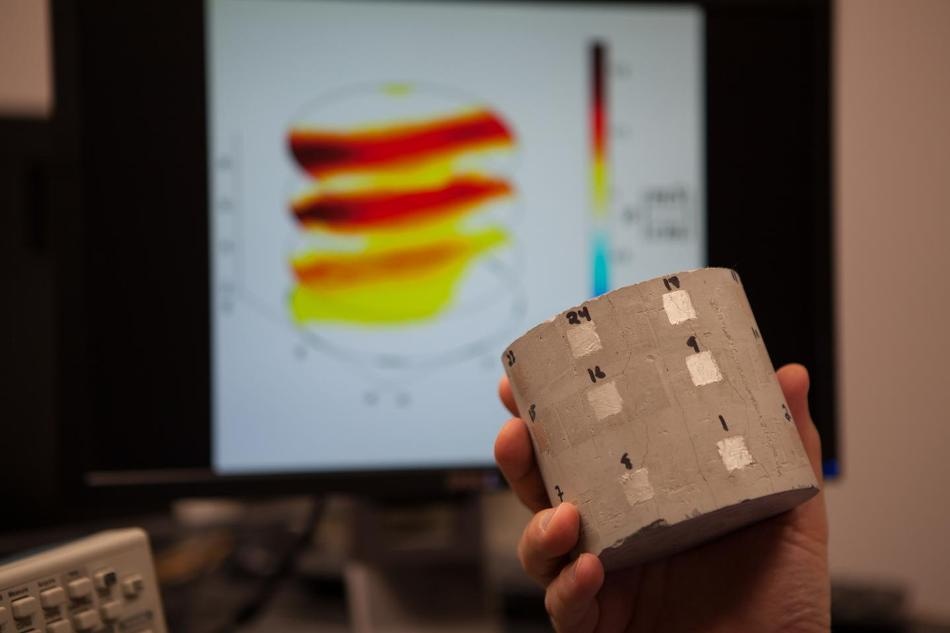Nov 2 2016
Researchers from North Carolina State University and the University of Eastern Finland have developed a new technique for tracking water in concrete structures – allowing engineers to identify potential issues before they become big problems.
 Researchers have developed a new technique for tracking water in concrete structures -- allowing engineers to identify potential issues before they become big problems. This photo shows one of the cracked samples tested in this work. Image at the background shows the flow of water in crack. (Credit: Julie Williams Dixon)
Researchers have developed a new technique for tracking water in concrete structures -- allowing engineers to identify potential issues before they become big problems. This photo shows one of the cracked samples tested in this work. Image at the background shows the flow of water in crack. (Credit: Julie Williams Dixon)
“When we think about construction – from bridges and skyscrapers to nuclear plants and dams – they all rely on concrete,” says Mohammad Pour-Ghaz, an assistant professor of civil, construction and environmental engineering at North Carolina State University and lead investigator on the project. Tracking concrete degradation is essential to public safety, and the culprit behind concrete degradation is water. Water contributes to the degradation by itself, or it can carry other chemicals – like the road salt used on bridges – that can expedite corrosion of both concrete and its underlying steel reinforcement structure.
“We have developed a technology that allows us to identify and track water movement in concrete using a small current of electricity that is faster, safer and less expensive than existing technologies – and is also more accurate when monitoring large samples, such as structures,” Pour-Ghaz says. “The technology can not only determine where and whether water is infiltrating concrete, but how fast it is moving, how much water there is, and how existing cracks or damage are influencing the movement of the water.”
Previous technologies for assessing water in concrete relied on X-rays or neutron radiation, but both have significant limitations. X-rays offer only limited penetration into concrete, making it impossible to use with large samples or on structures. Neutron radiation is more accurate, but also has limited penetration, is expensive, and poses health and safety risks.
“Our electrical imaging approach is something that you could use in the field to examine buildings or bridges, which would be difficult or impossible to do with previous technologies,” Pour-Ghaz says.
For their electrical imaging technique, researchers apply electrodes around the perimeter of a structure. A computer program then runs a small current between two of the electrodes at a time, cycling through a number of possible electrode combinations.
Every time the current runs between two electrodes, a computer monitors and records the electrical potential at all of the electrodes on the structure. The researchers then use their own customized software to compute the changes in conductivity and produce a three-dimensional image of the water in the concrete.
“By rapidly repeating this process – and we can do it even more than once per second – we can also capture the rate, and therefore the volume, of the water flow,” Pour-Ghaz says.
The researchers have already created and tested a prototype of the system in a lab, accurately capturing images of water flow in concrete samples that are too large to be analyzed using X-rays or neutron radiation. The researchers have also been able to monitor water flow through cracks in concrete, which is more difficult and time-consuming when older technologies are used.
“Our electrical imaging technology is ready to be packaged and commercialized for laboratory use, and we’d also be willing to work with the private sector to scale this up for use as an on-site tool to assess the integrity of structures,” Pour-Ghaz says.
The work is described in three papers. Lead author on all three papers is Danny Smyl, a Ph.D. student at NC State. All three papers were co-authored by Aku Seppänen, of the University of Eastern Finland, and Pour-Ghaz. “Can Electrical Impedance Tomography be used for imaging unsaturated moisture flow in cement-based materials with discrete cracks?” is published in the journal Cement and Concrete Research, and was co-authored by Reza Rashetnia, a Ph.D. student at NC State.
“Quantitative electrical imaging of three-dimensional moisture flow in cement-based materials” was published in International Journal of Heat and Mass Transfer. “Three-Dimensional Electrical Impedance Tomography to Monitor Unsaturated Moisture Ingress in Cement-Based Materials” was published in the journal Transport in Porous Media. Both papers were co-authored by Milad Hallaji, a former Ph.D. student at NC State.